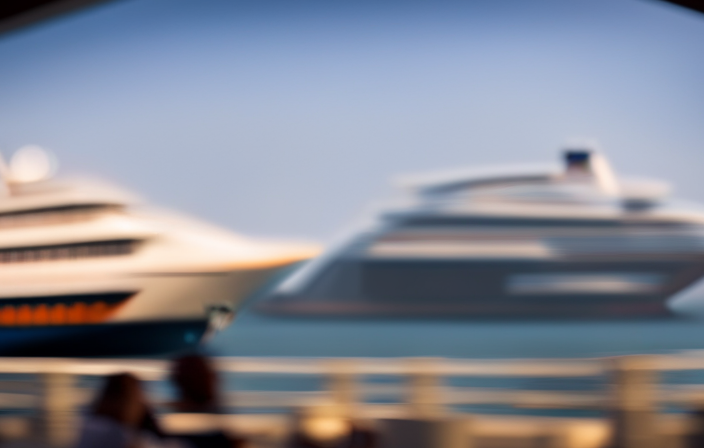Hello! Have you ever wondered how those huge cruise ships manage to sail into the harbor and dock so seamlessly? Well, you’re in luck because this article will take you on an online tour of the fascinating process of docking cruise ships.
Picture this: you’re standing on the deck of a magnificent cruise ship, eagerly awaiting the moment when you can step foot on land and embark on your grand adventure. But before that can happen, the ship must undergo a carefully orchestrated docking procedure.
From pre-docking preparations to securing the ship to the dock, every step is essential to ensure a safe and efficient docking experience. We’ll delve into the intricacies of approaching the port, communicating with port authorities, and maneuvering the ship into position.
So, grab your sailor’s hat, and let’s dive into the exciting world of how cruise ships dock. Get ready to unravel the secrets behind this maritime marvel!
Key Takeaways
- Customs clearance and document checks are necessary before a cruise ship can dock.
- The unloading and loading of cargo and supplies is a crucial part of the docking process.
- Effective logistics management is essential for a seamless transition during docking operations.
- Strict port regulations and safety protocols are followed during the departure process of a cruise ship.
Overview of the Docking Process
Once you’ve navigated through narrow channels and past bustling ports, you’ll find yourself expertly guided by skilled pilots as your cruise ship gracefully eases into its designated docking area. Docking a cruise ship may seem like a straightforward task, but it comes with its own set of challenges. The size and weight of the ship, as well as the currents and winds, can make docking a complex maneuver.
To assist in this process, cruise ships are equipped with advanced docking equipment, such as thrusters and bow and stern thrusters, which allow for precise control and maneuverability. These tools, combined with the expertise of the ship’s crew and the guidance of the pilots, ensure a smooth and safe docking experience.
Now, let’s delve into the crucial pre-docking preparation that takes place before this intricate maneuver.
Pre-Docking Preparation
Before arriving at the port, cruise liners undergo a series of delightful preparations to ensure a smooth docking process. This involves meticulous cargo handling and adherence to strict safety measures. To provide a seamless experience, the crew securely stows away loose items and ensures that all cargo is properly secured. They also conduct thorough inspections of the ship’s hull and machinery, ensuring everything is in working order.
Additionally, the crew prepares the gangway, a movable bridge that connects the ship to the dock, for safe passenger disembarkation. Safety drills are conducted, and lifeboats are checked to guarantee their functionality. The ship’s navigational officers closely monitor weather conditions and coordinate with port authorities to ensure a safe approach.
These pre-docking preparations set the stage for a successful docking process, as the ship approaches the port with precision and efficiency.
Approaching the Port
As you near the port, your anticipation grows, for the moment is approaching when the majestic vessel will gracefully glide towards its destination.
However, before the ship can dock, it must adhere to strict port regulations and overcome various docking challenges. These regulations ensure the safety and efficiency of the docking process. The captain and crew must carefully navigate the waterways, taking into account the depth, tides, and currents. Additionally, the size and maneuverability of cruise ships present unique challenges, requiring precise navigation to avoid collisions or damage to the ship or port infrastructure.
Once these challenges are overcome, the ship can proceed to communicate with port authorities to finalize the docking process. This communication ensures a smooth transition from approaching the port to the next step of the docking procedure.
Communication with Port Authorities
To smoothly transition from approaching the port to the next step of the docking procedure, you must navigate the waterways with precision, taking into account the depth, tides, and currents, while also communicating effectively with port authorities.
Communication protocols play a crucial role in ensuring the safe and efficient docking of cruise ships. Port regulations require ships to establish contact with the port authorities well in advance of their arrival. This communication allows the authorities to provide important information such as berth availability, docking procedures, and any specific instructions. It also enables the ship’s crew to relay important details about the ship’s size, draft, and propulsion capabilities.
By following these communication protocols and adhering to port regulations, the ship and the port authorities can work together seamlessly to facilitate a successful docking.
Transitioning into the subsequent section about maneuvering the ship into position, it is essential to understand the importance of precise navigation and effective communication.
Maneuvering the Ship into Position
Master the art of precision navigation and effective communication as you maneuver your ship into the perfect position for docking. Maneuvering a cruise ship into position requires skillful techniques and careful consideration of various factors. The size and design of the ship, wind and current conditions, and the layout of the port all pose unique challenges. To successfully dock a cruise ship, captains and navigators employ a range of maneuvering techniques such as bow thrusters, stern thrusters, and azipods. These systems allow for precise control and maneuverability, enabling the ship to navigate tight spaces and make accurate turns. Additionally, the crew must communicate with the port authorities to ensure a smooth docking process. This involves coordinating with tugboat operators, who provide assistance in maneuvering the ship into its final position. Utilizing these maneuvering techniques and overcoming docking challenges sets the stage for the next crucial step: using tugboats for assistance.
Using Tugboats for Assistance
Navigators rely on the guiding force of tugboats as they expertly glide the massive vessel into its designated position. Tugboat assistance is a crucial part of the docking technique for cruise ships.
These powerful boats use their engines and maneuverability to provide additional control and stability during the docking process. Tugboats work in tandem with the ship’s thrusters to safely navigate tight spaces and ensure a smooth approach to the dock. The experienced tugboat operators communicate with the ship’s bridge team, following their instructions to make precise adjustments and maintain the ship’s alignment.
Once the ship is in position, the tugboats assist in securing the ship to the dock, using ropes and lines to ensure a secure connection. This seamless transition sets the stage for the next step, securing the ship to the dock and preparing for passengers to disembark.
Securing the Ship to the Dock
After the tugs have successfully maneuvered the cruise ship into position, the next step in the docking process involves securing the ship to the dock. This is a crucial task that ensures the ship remains in place and prevents any unwanted movement. Various ship docking techniques are employed, utilizing a combination of ropes, lines, and docking equipment. These methods may include the use of bollards, cleats, and mooring lines, which are attached to the ship and firmly secured to the dock. The ship’s crew, working in coordination with the dock personnel, carefully fasten these connections to ensure stability and safety. This process requires precision and expertise to account for the ship’s size and weight. Once the ship is securely docked, preparations can begin for the next stage: disembarking passengers and cargo, which we will explore next.
Disembarking Passengers and Cargo
Passengers and cargo are unloaded from the ship, creating a bustling scene as people and goods flow onto the bustling dock. Ensuring passenger safety is of utmost importance during this process.
Cruise ships are equipped with gangways, which are movable bridges connecting the ship to the dock. These gangways are carefully positioned to allow passengers to disembark safely.
Once on the dock, passengers proceed through customs clearance, where their documents are checked and any necessary inspections are carried out.
Cargo is also unloaded from the ship, following strict protocols to ensure its safe handling and delivery.
After disembarking passengers and cargo, the ship prepares for the next phase of operations, which involves loading and unloading supplies.
This seamless transition between disembarking and loading supplies ensures smooth operations and efficient turnaround times.
Loading and Unloading Supplies
Supplies are efficiently loaded and unloaded to ensure smooth operations and quick turnaround times. In port operations, logistics management plays a crucial role in the loading and unloading process of cruise ships.
A well-coordinated system is in place to handle the vast amount of supplies required to sustain the ship and its passengers during the voyage. From food and beverages to toiletries and equipment, every item is carefully accounted for and organized.
A team of workers, equipped with forklifts and other machinery, carefully load and unload the supplies onto the ship. This process is time-sensitive, as it needs to be completed before the ship’s departure from the port.
Through effective logistics management, the loading and unloading of supplies ensure a seamless transition into the next phase of the journey.
Departure from the Port
As I set sail from the port, I can feel the excitement and anticipation building for the journey ahead.
The departure process from the port involves following strict port regulations to ensure a smooth and safe transition. Before leaving, the ship’s crew must complete various tasks, such as securing all loose items, ensuring proper navigation equipment is functioning, and conducting safety drills.
Additionally, port authorities conduct inspections to ensure compliance with regulations and verify the ship’s readiness for departure. Once all necessary checks are completed, the ship slowly moves away from the dock, guided by skilled pilots who navigate through the port’s narrow channels.
As we bid farewell to the port, passengers can enjoy the breathtaking views of the coastline while the ship gradually gains speed, embarking on a memorable journey at sea.
Frequently Asked Questions
What safety measures are in place to ensure the ship doesn’t collide with other vessels during the docking process?
To prevent collisions during the docking process, cruise ships have strict docking protocols in place. These protocols include using advanced navigation systems, maintaining constant communication with the bridge team, and having trained personnel on deck to guide the ship safely into the berth.
How are the docking positions assigned to different cruise ships at the port?
Assigning docking positions to different cruise ships at the port involves a systematic process known as berthing procedures. These procedures consider factors like cargo handling requirements and available space to ensure efficient and organized docking operations.
Are there any restrictions on the size or type of cruise ships that can dock at certain ports?
Yes, there are port restrictions that determine the maximum capacity and size of cruise ships that can dock at certain ports. These restrictions ensure the safety and suitability of the port for different types of cruise ships.
What happens if the weather conditions are unfavorable for docking the ship?
When weather conditions prevent docking, alternative methods like tendering or using smaller ports are employed. Unfavorable weather can disrupt cruise ship schedules, causing delays, changes in itinerary, and sometimes cancellation of port visits.
How are emergency situations handled during the docking process?
During the docking process, handling emergencies is crucial. Communication protocols are established to promptly address any emergency situations that may arise, ensuring the safety and well-being of passengers, crew, and the ship itself.
Conclusion
In conclusion, the process of docking a cruise ship may seem like a straightforward task, but it’s actually a complex and intricate operation.
From the pre-docking preparations to the final departure from the port, every step requires precision and careful coordination.
It’s a marvel to witness how these massive vessels gracefully maneuver into position and securely attach themselves to the dock.
So next time you see a cruise ship docking, take a moment to appreciate the skill and expertise involved in this seemingly ordinary yet extraordinary process.










